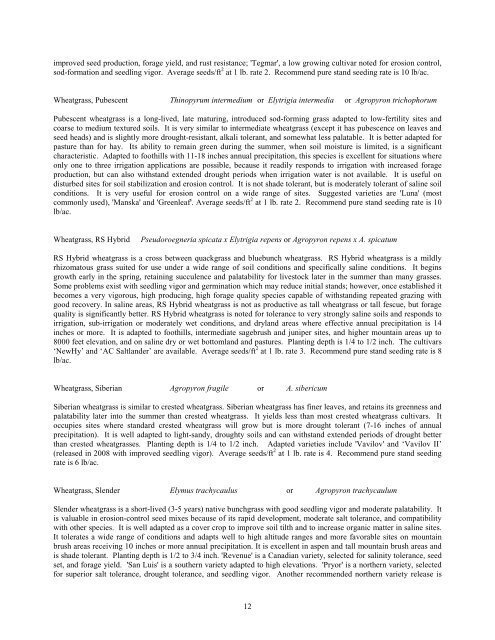Idaho Plant Materials Technical Note No. 24
Idaho Plant Materials Technical Note No. 24
Idaho Plant Materials Technical Note No. 24
You also want an ePaper? Increase the reach of your titles
YUMPU automatically turns print PDFs into web optimized ePapers that Google loves.
improved seed production, forage yield, and rust resistance; 'Tegmar', a low growing cultivar noted for erosion control,<br />
sod-formation and seedling vigor. Average seeds/ft 2 at 1 lb. rate 2. Recommend pure stand seeding rate is 10 lb/ac.<br />
Wheatgrass, Pubescent Thinopyrum intermedium or Elytrigia intermedia or Agropyron trichophorum<br />
Pubescent wheatgrass is a long-lived, late maturing, introduced sod-forming grass adapted to low-fertility sites and<br />
coarse to medium textured soils. It is very similar to intermediate wheatgrass (except it has pubescence on leaves and<br />
seed heads) and is slightly more drought-resistant, alkali tolerant, and somewhat less palatable. It is better adapted for<br />
pasture than for hay. Its ability to remain green during the summer, when soil moisture is limited, is a significant<br />
characteristic. Adapted to foothills with 11-18 inches annual precipitation, this species is excellent for situations where<br />
only one to three irrigation applications are possible, because it readily responds to irrigation with increased forage<br />
production, but can also withstand extended drought periods when irrigation water is not available. It is useful on<br />
disturbed sites for soil stabilization and erosion control. It is not shade tolerant, but is moderately tolerant of saline soil<br />
conditions. It is very useful for erosion control on a wide range of sites. Suggested varieties are 'Luna' (most<br />
commonly used), 'Manska' and 'Greenleaf'. Average seeds/ft 2 at 1 lb. rate 2. Recommend pure stand seeding rate is 10<br />
lb/ac.<br />
Wheatgrass, RS Hybrid<br />
Pseudoroegneria spicata x Elytrigia repens or Agropyron repens x A. spicatum<br />
RS Hybrid wheatgrass is a cross between quackgrass and bluebunch wheatgrass. RS Hybrid wheatgrass is a mildly<br />
rhizomatous grass suited for use under a wide range of soil conditions and specifically saline conditions. It begins<br />
growth early in the spring, retaining succulence and palatability for livestock later in the summer than many grasses.<br />
Some problems exist with seedling vigor and germination which may reduce initial stands; however, once established it<br />
becomes a very vigorous, high producing, high forage quality species capable of withstanding repeated grazing with<br />
good recovery. In saline areas, RS Hybrid wheatgrass is not as productive as tall wheatgrass or tall fescue, but forage<br />
quality is significantly better. RS Hybrid wheatgrass is noted for tolerance to very strongly saline soils and responds to<br />
irrigation, sub-irrigation or moderately wet conditions, and dryland areas where effective annual precipitation is 14<br />
inches or more. It is adapted to foothills, intermediate sagebrush and juniper sites, and higher mountain areas up to<br />
8000 feet elevation, and on saline dry or wet bottomland and pastures. <strong>Plant</strong>ing depth is 1/4 to 1/2 inch. The cultivars<br />
‘NewHy’ and ‘AC Saltlander’ are available. Average seeds/ft 2 at 1 lb. rate 3. Recommend pure stand seeding rate is 8<br />
lb/ac.<br />
Wheatgrass, Siberian Agropyron fragile or A. sibericum<br />
Siberian wheatgrass is similar to crested wheatgrass. Siberian wheatgrass has finer leaves, and retains its greenness and<br />
palatability later into the summer than crested wheatgrass. It yields less than most crested wheatgrass cultivars. It<br />
occupies sites where standard crested wheatgrass will grow but is more drought tolerant (7-16 inches of annual<br />
precipitation). It is well adapted to light-sandy, droughty soils and can withstand extended periods of drought better<br />
than crested wheatgrasses. <strong>Plant</strong>ing depth is 1/4 to 1/2 inch. Adapted varieties include 'Vavilov' and ‘Vavilov II’<br />
(released in 2008 with improved seedling vigor). Average seeds/ft 2 at 1 lb. rate is 4. Recommend pure stand seeding<br />
rate is 6 lb/ac.<br />
Wheatgrass, Slender Elymus trachycaulus or Agropyron trachycaulum<br />
Slender wheatgrass is a short-lived (3-5 years) native bunchgrass with good seedling vigor and moderate palatability. It<br />
is valuable in erosion-control seed mixes because of its rapid development, moderate salt tolerance, and compatibility<br />
with other species. It is well adapted as a cover crop to improve soil tilth and to increase organic matter in saline sites.<br />
It tolerates a wide range of conditions and adapts well to high altitude ranges and more favorable sites on mountain<br />
brush areas receiving 10 inches or more annual precipitation. It is excellent in aspen and tall mountain brush areas and<br />
is shade tolerant. <strong>Plant</strong>ing depth is 1/2 to 3/4 inch. 'Revenue' is a Canadian variety, selected for salinity tolerance, seed<br />
set, and forage yield. 'San Luis' is a southern variety adapted to high elevations. 'Pryor' is a northern variety, selected<br />
for superior salt tolerance, drought tolerance, and seedling vigor. Another recommended northern variety release is<br />
12
















